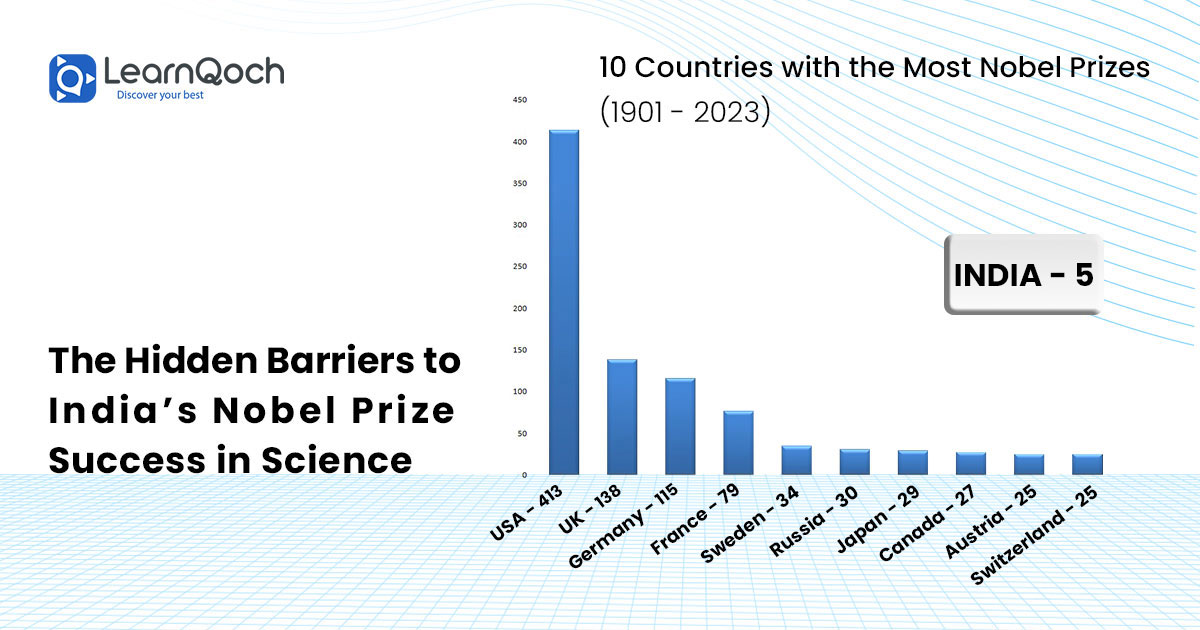The Hidden Barriers to India’s Nobel Prize Success in Science
India, a land of great intellect and rich history in science, has surprisingly bagged only one Nobel Prize in science. Dr. C.V. Raman, who won the prize in 1930 for discovering the Raman Effect, remains a lone figure in India’s history of Nobel laureates in science. Despite the country’s large population and growing economy, only five Indian citizens have ever received a Nobel Prize. What exactly is holding back a nation with such potential from becoming a global leader in research and development? Let’s dive deeper.
Why Does India Struggle in Research and Development?
- Lack of a Culture that Celebrates Innovation
In India, there is a preference for quick wins rather than building something new and original. Society has cultivated a culture of trading and service-based industries, which yield faster returns but often lack long-term innovation. Additionally, there is little recognition of the value of failure, which is crucial for scientific progress. Innovation requires trial and error, but without a culture that encourages risk-taking, it’s challenging for young minds to develop a research mindset. - Pressure to Score Grades, Not to Innovate
In the K-12 education system, the focus is on grades rather than fostering curiosity and creativity. Most parents prioritize sending their children to coaching classes that help them score high in exams rather than encouraging hands-on experiments in science labs. Every year, India churns out about 1.5 million engineering graduates, yet many struggle to find meaningful jobs because they lack research-oriented skills that the job market demands. - Limited Appeal of STEM Careers Beyond Engineering and Medicine
Careers in STEM (Science, Technology, Engineering, and Mathematics) are still overshadowed by traditional professions like engineering and medicine. There’s a lack of emphasis on developing young minds to pursue research-driven careers within these fields. A culture that rewards curiosity and innovative thinking is essential to nurture the next generation of scientists. - Absence of a Robust R&D Community in Education
Unlike other countries, India lacks a strong research and development (R&D) ecosystem at both the K-12 and higher education levels. There is no structured platform where students, educators, and industry experts can collaborate to work on groundbreaking research. Creating such communities within schools, colleges, and universities could significantly impact students’ approach to learning and innovation. - Insufficient Government Incentives for R&D in Education
While the government has made some efforts to promote R&D, there is still a long way to go. Schools, colleges, and universities often do not receive structured rewards or funding for promoting research-oriented activities. Without adequate incentives, educational institutions have little motivation to prioritize research.
Can India Lead the World in Research and Development?
Absolutely. With over 300 million students spanning from kindergarten to post-graduate (KG to PG), even if 0.1% of these students are identified and nurtured for their potential in research, India could create a significant global impact.
What Steps Should India Take to Become a Global R&D Hub?
- Prevent Talent Drain
It is vital to recognize students who show promise in research and reward them early. Scholarships, awards, and funding can help retain talent and reduce the need for researchers to leave the country in search of better opportunities. - Promote STEM Education with Practical Learning
Encourage students to engage with real-world problems through hands-on experiences in science labs instead of focusing solely on theoretical knowledge. Cultivating a spirit of inquiry from an early age will help create a new generation of scientists who think outside the box. - Establish High-Tech Research-Oriented Educational Institutions
India needs specialized research-oriented schools, colleges, and universities that focus on developing students’ research skills and technological expertise. These institutions should foster an environment where innovative thinking is the norm. - Provide Funding for International Collaborations
Allocate 100% funding for students and researchers who want to collaborate on international research projects. Scholarships and grants can enable them to gain exposure and bring global perspectives back to India. - Celebrate Failures and Reward Risk-Taking
In science, failure is not the opposite of success but a part of it. Encouraging students to take risks and rewarding attempts, even if they fail, can cultivate a culture of innovation where students are motivated to create something new rather than opting for safe, conventional careers.
The Road Ahead
With a GDP of around $3.57 trillion in 2023 and projections to reach $6 trillion by the end of the decade, India has the economic muscle to boost its investment in research and development. The government and private sector should work hand-in-hand to allocate more funds to R&D and create an environment where future Nobel laureates can emerge from India.
It’s time for India to shift its focus towards building a future that celebrates innovation, encourages risk-taking, and places value on research. Let’s create a country where young minds grow up not just aspiring to be doctors or engineers, but aiming to push the boundaries of human knowledge and make a global impact.
Learn more about the Nobel Prize and its history.
#NobelPrizeIndia #IndianInnovation #STEMEducation #ResearchAndDevelopment
People Also Ask:
- How to read the minds of students to check their concept understanding daily?
- The guide on Online learning platforms for schools & its benefits.
- How to manage content in LMS for Schools?
- How to create questions in LMS for schools?
Call us at +91 84519 01079 || Email us at info@learnqoch.com




